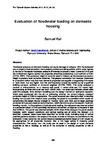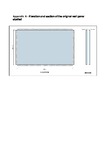Evaluation of floodwater loading on domestic housing
| dc.contributor.author | Kail, S. | |
| dc.date.accessioned | 2019-05-20T15:57:48Z | |
| dc.date.available | 2019-05-20T15:57:48Z | |
| dc.date.issued | 2017 | |
| dc.identifier.citation |
Kail, S. (2017) 'Evaluation of floodwater loading on domestic housing', The Plymouth Student Scientist, 10(2), p. 80-133. | en_US |
| dc.identifier.issn | 1754-2383 | |
| dc.identifier.uri | http://hdl.handle.net/10026.1/14162 | |
| dc.description.abstract |
Floodwater pressure on domestic housing can cause damage or collapse. With the increased use of property level protection, more property owners are taking actions to limit water ingress at the cost of increased floodwater pressure differential on property walls. Currently CIRIA and the Environment Agency advise that properties should be protected up to a maximum of 0.6m (CIRIA, 2007). This protection height is currently used in industry as the standard protection height in property level protection schemes. The general consensus from sources referenced in a literature review was that most domestic properties are capable of supporting 0.6 meters of flood water, but any higher than this and inspection should be carried out by a qualified building surveyor, architect or structural engineer (ODPM, 2003). This study analysed a number of characteristics for a masonry wall panel, 4 meters wide and 2.5 meters high, incorporating an inner and outer leaf both 100mm thick. The analytical methods utilised were yield line analysis, finite element modelling and the design moment of resistance equation, which were conducted with the aim of arbitrating whether the current industry standard protection height of 0.6m is appropriate. The panel analysed was deemed suited to resisting loading from a static 0.6m head of water, providing the panel is in a condition which would not compromise the design flexural strength or material factor; and there are no large openings protected with property level protection barriers, which demonstrated an increase in maximum bending moment. In the presence of hydrodynamic loading, the wall panel was deemed suited to a protection height of 0.6m providing the velocity component orthogonal to the panel is less than 0.03m/s. The panel was deemed suitable within these limits because the panel section modulus, width, support conditions and vertical loading are all within the relevant ULS identified. However, areas have been identified for further study, including study of further yield line patterns outside of the scope of this study, in order to increase the confidence in this arbitration. It was found that the current industry standard protection height of 0.6m would not be appropriate for all properties however, due to the huge variety in masonry panel characteristics. The results from this study can be used in the design of future domestic properties at risk of flooding, as well as in the protection of existing properties at risk of flooding. | en_US |
| dc.language.iso | en | en_US |
| dc.publisher | University of Plymouth | |
| dc.rights | Attribution 3.0 United States | * |
| dc.rights.uri | http://creativecommons.org/licenses/by/3.0/us/ | * |
| dc.subject | Floodwater pressure on domestic housing | en_US |
| dc.subject | property walls | en_US |
| dc.subject | masonry wall panel | en_US |
| dc.subject | risk of flood | en_US |
| dc.subject | protection height | en_US |
| dc.title | Evaluation of floodwater loading on domestic housing | en_US |
| dc.type | Article | |
| plymouth.issue | 2 | |
| plymouth.volume | 10 | |
| plymouth.journal | The Plymouth Student Scientist |




